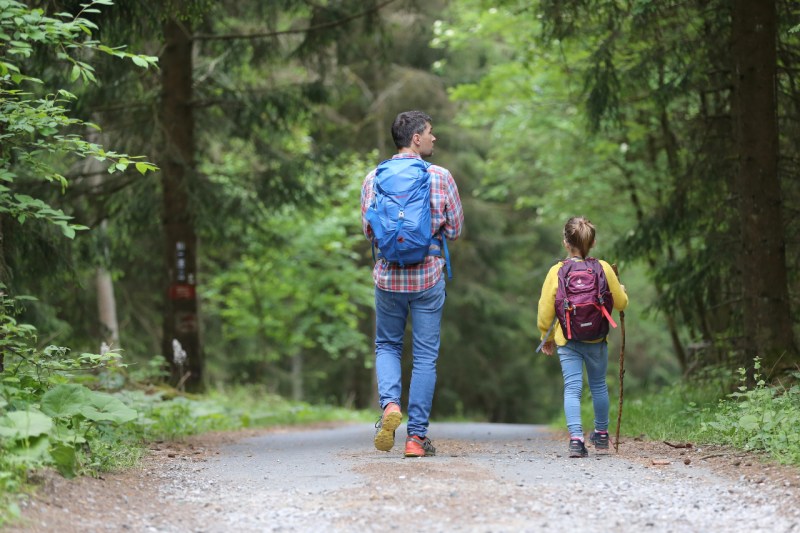First impressions are a big deal, especially when you’re trying to get your kids excited about nature. If you’ve never taken your kiddos on a hike before, it’s really never too late. Kids of all ages can benefit from the fresh air and exercise. Overall, hiking with your kids is a healthy bonding experience that the entire family can enjoy, provided you plan correctly, keep things fun, and encourage your kids to be adventurous along the way.
Not every pre-teen is going to love being dragged away from their devices, but it’s a great thing to make them touch some grass every once in a while. So whether you’re hiking with a toddler or bringing your older kids away from technology, here are some suggestions to make hiking with kids of all ages a rewarding adventure for everyone.
Choose your trail carefully

I’ve made this mistake early on with kiddos. If you don’t pay attention to the miles you’re hoping to cover, your kids will get tired out before half the hike is over. After all, tiny legs can only cover so much ground. Younger kids are going to become tired faster than the older kids, so choose a hike that you know the youngest one can handle, or be prepared to give some piggyback rides.
If you go 3 miles out, then that involves 3 miles back, so if possible, pick trails with natural loops that bring you back to a starting point near the car. It might take a few outings to understand the limits of your kids, but be in tune with their needs and don’t be afraid to turn around if you sense that they’re done.
Prepare the night before

Waiting to pack until the morning of a hike is never a good idea. The night before the trip, make a list of all the things you and the kids will need. Bring along copious amounts of snacks (more on that in a second), binoculars, trekking poles, a small shovel for excavating, a notepad to write down items of interest, an extra pair of socks for each kid in case the terrain gets sloppy, sunblock, wipes, antiseptic spray, and some bandages. Pack a bag as though you’re going to live outside for a while.
The reason you’re better off packing the night before is that you’re more likely to remember everything during the extra time. I know firsthand how tossing items in a bag 20 minutes before piling into the car is a surefire way to forget essential items.
My suggestion is to overpack a bag while keeping in mind that the more stuff you jam into a backpack, the heavier your bag will be on your back all day. Unless you’ve got older kids who can shoulder (literally) some of the load, you’ll be the person lugging the stuff around, so keep this in mind before filling your pack with unnecessary items.
Snacks are crucial

Packing enough snacks for an afternoon in the woods is essential when going hiking with kids. In fact, I’ll argue that not bringing enough food, drinks, and snacks can derail an otherwise fantastic day in the wilderness. Be sure to pack a wide variety of options — salty, sweet, and healthy — and bring along enough water to put out a small forest fire. The kids will be chugging liquids every time you stop to check the map.
Hiking is one of the few times I’m perfectly fine with my kids eating sugary snacks. Whatever keeps them hyper and ready to tackle more miles. Shameless bribes are sometimes necessary, so I’ll also use candy and sugar as an incentive to keep going until the next stop.
Let the kids lead the way

It’s important to let kids think they’re in control of the adventure, even though they’re just following a man-made trail around in the woods, so let the kids set the pace. Ask for their advice along the way about where to head next. “Should we take the blue trail or the yellow trail?” Allow them to make some choices for the family. Let them choose when and where to stop. Don’t try and push them along every time they stop to stare at rocks, weird bugs, funky-looking mushrooms, massive spiderwebs, and random creatures. Hiking with kids will involve a lot of stopping, so be ready.
Speaking of stopping to take in the sights, use this time to commend the kids on how well they’re doing so far. Go above and beyond by telling your kid how they’re crushing this hike, how good they are at scaling the rocks and jumping over tree roots, and how strong they look. Be sure to use this positive reinforcement even if they’re not really doing that well.
Let them bring home souvenirs

While letting kids bring home souvenirs like rocks, sticks, and leaves might seem harmless, these items have a role to play in our ecosystem and are better left where you found them. This is one of the pivotal principles of the Leave No Trace organization, which preaches that this is one of the most important rules to follow while out in the wilderness.
That doesn’t mean you shouldn’t let your kids interact with nature! Let them find sticks that make for the perfect walking sticks, swords, or magic wands, but ultimately leave them on the hike. There are so many other ways to give your kids mementos from the adventure. Photos are great, but you can also teach them how to do leaf rubbings or shadow tracings.
Another great way to keep kids engaged in nature without breaking leave no trace principles is to have your kids bring sketchbooks and colored pencils for break times. Create a nature scavenger hunt where they can check off items from a list instead of collecting them, or even give your kids an old-fashioned digital camera for a nature photography challenge. Hopefully, these ideas will spark some thoughts about what your own kids would like to do.
Don’t force hiking on them

A few years ago, I coached my son’s lacrosse team. The kids were ages 6 to 9. Before the season started, the league held a coach’s clinic to go over the rules. One of the league organizers gave this one final instruction to all parents and coaches in attendance. “You have one job this season — make sure the kids have fun and don’t hate the sport.”
The same is true for hiking. Just make sure the kids have fun and don’t hate wandering around the woods all day. You want the kids to have as much fun as possible. If things aren’t going according to plan, don’t freak out.
Hiking with kids is all about what you make of the time spent together. Make the experience as much fun as possible, and your kids will be begging to go




